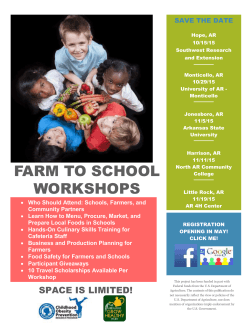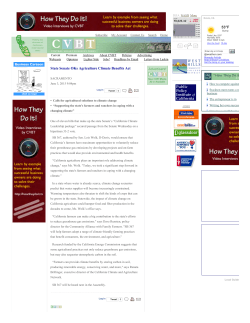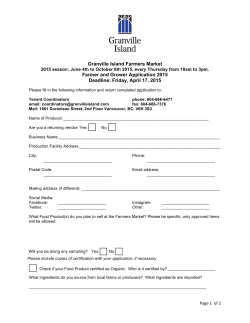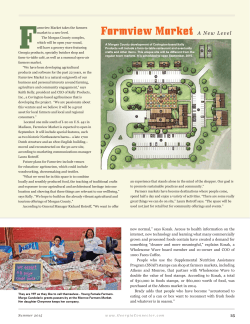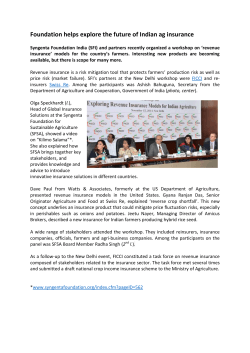
Publication - Ibrahim Ghaznavi
VillageApps - A platform to educate underprivileged
communities in their mother tongue
Ibrahim Ghaznavi, Umar Muneer, Usman Shahid
Shan Randhawa, Kashif Ali, Tapan Parikh, Umar Saif
Information Technology University
University of California, Berkeley
{ighaznavi, umuneer, ushahid, srandhawa, umar}@itu.edu.pk
{kashif, parikh}@berkeley.edu
ABSTRACT
Illiteracy is one of the biggest development challenges, especially in the developing regions. There are 785M adult illiterates in the world; one in every five people has little or no
basic reading skills. Illiteracy poses the following challenges:
It limits the ability to understand essential information, it
increases unemployment, poverty and it has a negative impact on health.
In this study, we present VillageApps - a framework to educate underprivileged communities in their mother tongue.
The paper details the platform, its functionality, and its initial evaluation on a group of 30 school-aged children. Our
framework consists of a web and a mobile application; the
web application provides an interface to upload content and
record its page by page audio translation; the mobile application provides an interface to view each page and simultaneously listen to its audio translation.
dren in the fifth grade are unable to subtract two numbers
and read a sentence in English [1]. Access to information
in rural areas is sparse, and there is an acute shortage of
primary-school teachers [9]. The main problems hindering
educational activities in rural areas are: poor readability,
difficulty in learning a new language, and textual illiteracy.
The availability of reading material in a learner’s mother
tongue can improve reading skills [10].
Information and communication technologies can bridge
the knowledge divide by enabling people to learn in their
Mother tongue. VillageApps is a platform that provides
reading illiterates access to educational content in their mother
tongue.
2.
ICTS FOR INFORMATION DISSEMINATION
Categories and Subject Descriptors
This section discusses some existing innovative ICT solutions to spread relevant information to different groups of
under-privileged rural communities.
H.5.2 [User Interfaces and Presentation]: [User-centered
design]
2.1
Voice based solution for farmers
Keywords
Knoche et al [4] use audio to share pertinent information with the illiterate farmers in their local language. The
prime motive of this approach is to help farmers adapt to
good farming practices by improving access to trustworthy
information. It does not have pictorial or video multimedia
support to aid the voice content.
ICTD; rural development; computing for development; mobile for development; literacy
2.2
General Terms
Design, Human Factors
1.
INTRODUCTION
Pakistan’s 5.5 million school-aged children do not attend
school. In the province of Baluchistan, about half of the chilPermission to make digital or hard copies of all or part of this work for personal or
classroom use is granted without fee provided that copies are not made or distributed
for profit or commercial advantage and that copies bear this notice and the full citation on the first page. Copyrights for components of this work owned by others than
ACM must be honored. Abstracting with credit is permitted. To copy otherwise, or republish, to post on servers or to redistribute to lists, requires prior specific permission
and/or a fee. Request permissions from Permissions@acm.org.
ICTD ’15, May 15 - 18, 2015, Singapore, Singapore
Copyright 2015 ACM 978-1-4503-3163-0/15/05 $15.00
http://dx.doi.org/10.1145/2737856.2737904.
Featherweight multimedia
Chu et al [2] combine printed paper brochures displaying
categorization of the content, along with the number corresponding to each category, and a multimedia device which
takes a number as an input and reads-out-loud its audio representation (in the native language). This approach requires
printing equipment and some expertise to create customized
information brochures.
2.3
Talking Book
Talking Book is a battery powered, portable gadget which
stores and plays voice recordings. It disseminates important
information created by local experts, to the rural communities in their native language [8]. Information can assist
farmers, health care professionals and micro-finance organizations. It can be difficult to explain complex content i.e.
which is not very obvious or which is not already in their
routine vocabulary.
3. Volunteer translator(s) can look for the books (pending
translations);
2.4
4. Several translators can pool-in their time to collectively translate a book;
Video Viewing Club
David et al [3]use multimedia video(s) to train farmers
on complex technical topics. The study improved farmers
knowledge of the topics covered in the videos. Some of the
farmers complained about the length of the videos. Creation
of videos is a complex process that requires specialized professionals. In such a scenario, a user does not have the luxury
to proceed at his or her own pace.
2.5
Others
Avaaj Otalo - an interactive voice messaging forum for
small-scale farmers to disseminate farming knowledge and
also ask/answer question on a variety of issues [6]. It is
a voice only learning technique for which users need to be
familiar with IVR systems. Ramachandran et al proposed
the use of mobile-phone videos to train health workers [7].
The video content was created using video clips and still
images. As opposed to the video viewing club, it removed
the constraint to view a video at a designated community
center by enabling health workers to view video content at
their home or any convenient location. Molapo et al also
proposed a similar learning technique based on mobile phone
videos to train health workers in Sierra Leone and Lesotho
[5].
Figure 2: Mobile Application
3.2
Mobile application
The mobile application, as shown in Figure 2, enables a
user to browse through existing categories such as, education, health, news and weather(can add more). Each category can have a number of items. The mobile application
only show books whose complete recordings are available
for download. When a particular book is selected it allows
following navigations:
1. Move to the next page;
2. Move to the previous page;
3. Play / pause control;
4. Return to category list;
Figure 1: Web Application
3.
PROPOSED SOLUTION
With some limitations of the existing systems in mind we
started our research to devise a platform which can enable
learning in native language. The solution is designed to work
for illiterate or lesser educated users.
3.1
Web application
Our framework consists of a web and a mobile application.
The web application, as shown in Figure 1, provides an interface to the volunteer translators to upload(pdf), record
and store voice translations of any useful content or book.
All the voice-translations are stored page by page. Our application is accessible at: www.villageapps.org. The web
application allow the following functionalities:
1. Anyone can explore already translated books;
2. Anyone can upload a pdf content/book;
Moving to the next or the previous page automatically
plays the associated voice translation of that page. The navigation controls enable learning at user’s customized pace.
4.
INITIAL FIELD-TEST AND SURVEY
We conducted a survey on a group of 30 volunteer children to study the effectiveness of our framework. The volunteers were either early school drop-outs , or never attended
school. The volunteers can speak and understand, but can
not read Urdu. Using our Web-App a volunteer translator
audio recorded page by page translation in Urdu language
for the mathematics book of class 1. The book includes
basic math lessons like number counting, sorting and comparison. A questionnaire was designed for each maths lesson
to study the impact of our application on the learnability of
the volunteers. We calculated the percentage of volunteers
who answered correctly before and after taking mathematics
lessons using our Mobile-App. Some interesting findings are
as follows:
MCQs based questionnaire was designed to evaluate the
performance of the participants(read-illiterate) in counting,
comparison and sorting mathematics lessons. Each questionnaire was filled with the help of a volunteer reader. The
counting questionnaire contain 9 questions, each question
has 4 choices; a participant was requested to mark the correct choice for a question for example: Which of the following number if eight (options: 1,8,9,4)? Figure 3 shows
the percentage of people who answered correctly. Column 2
and 3 shows the percentage of participants who correctly answered before and after taking the VillageApps mathematics
tutorial, respectively. Column 4 shows the percentage difference (or improvement) between before and after tutorial
scenarios.
Figure 5: Comparison results
5.
Figure 3: Counting results
Figure 4 shows the percentage of people who answered
correctly before and after taking the comparison lesson. After VillageApps tutorial there is a percentage improvement
for all the questions except 2 comparison questions.
Figure 4: Sorting results
Figure 5 shows the percentage of people who answered
correctly before and after taking the sorting lesson. Post
VillageApps tutorial there is a percentage improvement for
all the questions.
CONCLUSION AND FUTURE WORK
In this study, we examined the potential of VillageApps,
a framework to disseminate information to the underprivileged communities in their mother tongue. We conducted
an initial field-test on a group of 30 volunteers. We noticed that after taking the VillageApps basic maths tutorials,
more participants were able to perform better in counting,
comparison and sorting tests.
We are working with the government of Pakistan to create subject lessons for class 1-6 with the help of VillageApps
framework. Government already has the content for class 610, which is currently being taught in 256 school all across
Pakistan (content accessible at: http://elearn.punjab.gov.pk/)
6.
REFERENCES
[1] Teaching and learning: Achieving quality for all.
http://unesdoc.unesco.org/images/0022/002256/
225660e.pdf. [Online; accessed 21-Dec-2014].
[2] G. Chu, S. Satpathy, K. Toyama, R. Gandhi,
R. Balakrishnan, and S. R. Menon. Featherweight
multimedia for information dissemination. In
Information and Communication Technologies and
Development (ICTD), 2009 International Conference
on, pages 337–347. IEEE, 2009.
[3] S. David and C. Asamoah. Video as a tool for
agricultural extension in africa: a case study from
ghana. International Journal of Education and
Development using ICT, 7(1):26–41, 2011.
[4] H. Knoche, P. S. Rao, and J. Huang. Voices in the
field: A mobile phone based application to improve
marginal farmers livelihoods. In Proceedings of SIMPE
workshop, number EPFL-CONF-173172, 2010.
[5] M. Molapo and G. Marsden. The potential of mobile
video as a medium for training low literate audiences.
[6] N. Patel, D. Chittamuru, A. Jain, P. Dave, and T. S.
Parikh. Avaaj otalo: a field study of an interactive
voice forum for small farmers in rural india. In
Proceedings of the SIGCHI Conference on Human
Factors in Computing Systems, pages 733–742. ACM,
2010.
[7] D. Ramachandran, J. Canny, P. D. Das, and
E. Cutrell. Mobile-izing health workers in rural india.
In Proceedings of the SIGCHI Conference on Human
Factors in Computing Systems, pages 1889–1898.
ACM, 2010.
[8] C. Schmidt, T. J. Gorman, A. A. Bayor, and M. S.
Gary. Impact of low-cost, on-demand, information
access in a remote ghanaian village. In Proceedings of
the 4th ACM/IEEE International Conference on
Information and Communication Technologies and
Development, page 43. ACM, 2010.
[9] A. K. Wong, S. Y. Tang, and M. M. Cheng. Teaching
motivations in hong kong: Who will choose teaching
as a fallback career in a stringent job market?
Teaching and Teacher Education, 41:81–91, 2014.
[10] T. L. Zuze and V. Reddy. School resources and the
gender reading literacy gap in south african schools.
International Journal of Educational Development,
36:100–107, 2014.
© Copyright 2025
